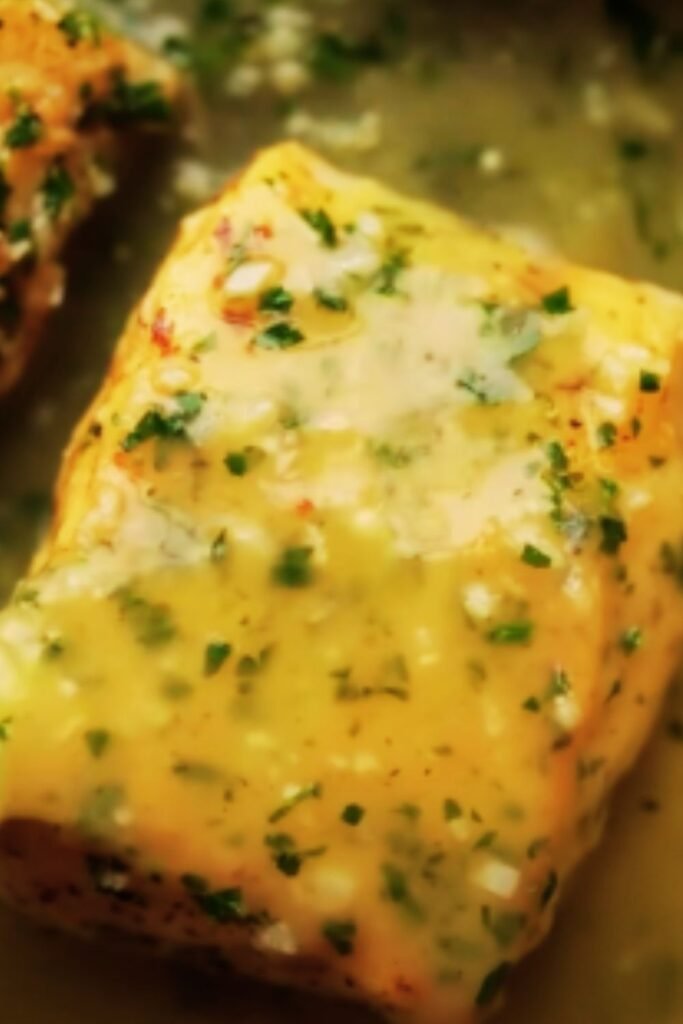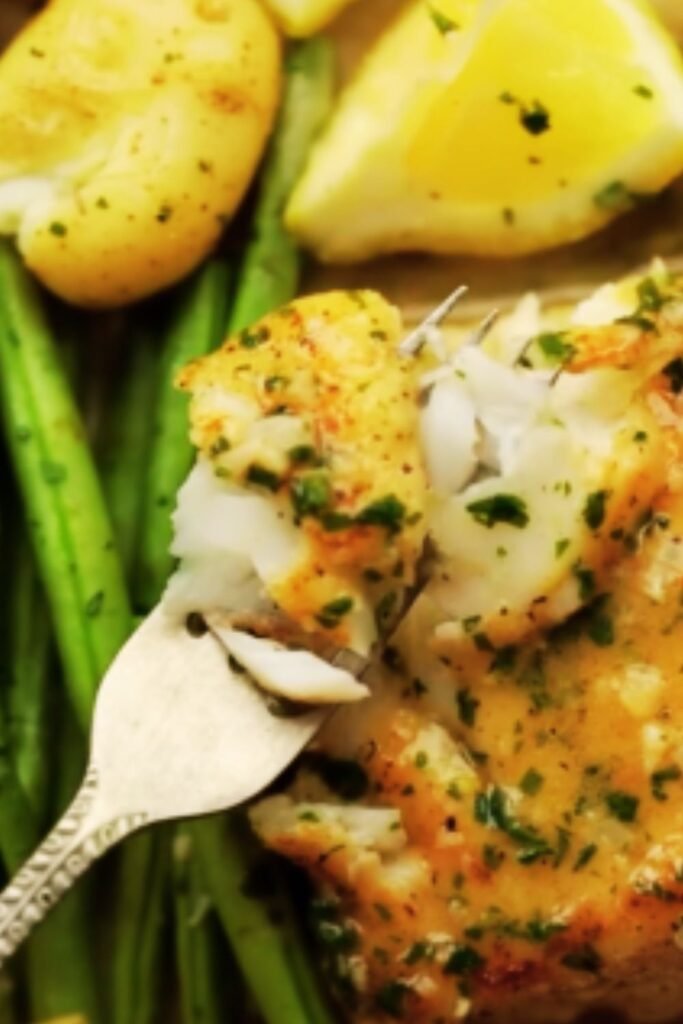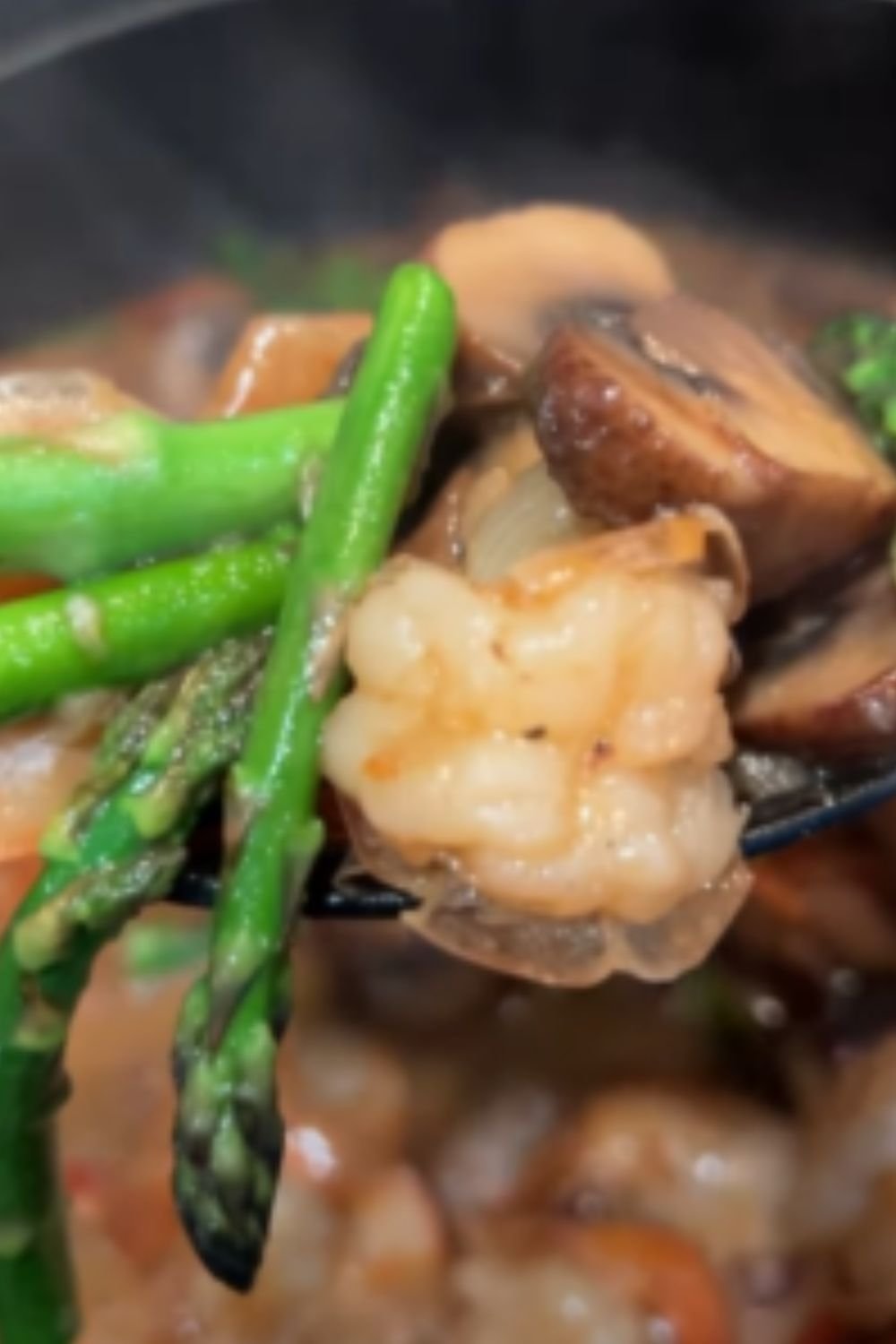Have you ever wanted to bring a taste of the tropics to your dinner table without spending hours in the kitchen? I’ve discovered the perfect solution: baked cod in coconut lemon cream sauce. This dish combines the delicate flavor of cod with the rich creaminess of coconut and the bright acidity of lemon to create a meal that’s both impressive and surprisingly simple to prepare.
As someone who’s been cooking seafood for over a decade, I’ve experimented with countless fish recipes, but this one has become a staple in my home. The combination of tender, flaky cod bathed in a velvety coconut sauce infused with lemon is truly magical. The best part? It takes less than 30 minutes to prepare from start to finish.
Why You’ll Love This Dish
This baked cod recipe is more than just delicious—it’s a versatile dish that works for both weeknight dinners and special occasions. The coconut lemon cream sauce elevates an otherwise simple fish into something extraordinary, yet the ingredients are likely already in your pantry or easy to find at any grocery store.
What makes this dish truly special is how the mild, slightly sweet flavor of cod pairs perfectly with the tropical notes of coconut milk and the brightness of fresh lemon. The sauce is rich without being heavy, and it infuses the fish with moisture and flavor as it bakes.
Ingredients You’ll Need
For the perfect baked cod in coconut lemon cream sauce, gather these ingredients:
For the Fish:
- 1½ pounds fresh cod fillets (about 4 pieces)
- ½ teaspoon sea salt
- ¼ teaspoon freshly ground black pepper
- ½ teaspoon garlic powder
- ¼ teaspoon paprika
- 1 tablespoon olive oil
For the Coconut Lemon Cream Sauce:
- 1 tablespoon butter
- 2 cloves garlic, minced
- 1 small shallot, finely diced
- 1 cup full-fat coconut milk
- 2 tablespoons fresh lemon juice
- 1 teaspoon lemon zest
- 1 tablespoon fresh dill, chopped (plus more for garnish)
- 1 tablespoon fresh parsley, chopped
- ½ teaspoon red pepper flakes (optional)
- Salt and pepper to taste
Essential Equipment
- Baking dish (9×13 inches works well)
- Saucepan
- Whisk
- Measuring cups and spoons
- Cutting board and knife
- Zester or microplane
- Aluminum foil
Preparation Step-by-Step
Follow these steps to create your coconut lemon cream baked cod:
Preparing the Fish:
- Preheat your oven to 375°F (190°C).
- Pat the cod fillets dry with paper towels. This step is crucial for proper seasoning adhesion and texture.
- In a small bowl, mix together salt, pepper, garlic powder, and paprika.
- Season both sides of the cod fillets with this spice mixture.
- Lightly grease a baking dish with olive oil and arrange the seasoned fillets in a single layer.
Making the Coconut Lemon Cream Sauce:
- In a medium saucepan, melt the butter over medium heat.
- Add the minced garlic and diced shallot, sautéing until fragrant and translucent (about 2-3 minutes). Be careful not to brown the garlic as it can become bitter.
- Pour in the coconut milk, stirring to combine with the garlic and shallot.
- Add the lemon juice and zest, stirring constantly to prevent the coconut milk from separating.
- Reduce the heat to medium-low and simmer for 5 minutes until the sauce begins to thicken slightly.
- Stir in the fresh dill, parsley, and red pepper flakes (if using).
- Season with salt and pepper to taste. The sauce should have a balanced flavor—creamy from the coconut milk with a noticeable brightness from the lemon.
Baking the Cod:
- Pour the coconut lemon cream sauce evenly over the cod fillets in the baking dish, ensuring each piece is well-coated.
- Cover the dish with aluminum foil. This helps trap moisture and ensures the fish cooks evenly.
- Bake for 15-18 minutes, or until the fish easily flakes with a fork. The exact cooking time will depend on the thickness of your fillets.
- For a slightly golden top, remove the foil during the last 3-4 minutes of baking.
- Garnish with additional fresh dill and lemon slices before serving.

The Science Behind Perfect Baked Cod
Understanding why this recipe works helps you achieve perfect results every time:
Cooking Temperature
Baking cod at 375°F (190°C) is ideal because:
- It’s hot enough to cook the fish quickly, preventing it from drying out
- It allows the sauce to simmer gently around the fish, infusing flavor
- It’s not so hot that the coconut milk will separate or curdle
The Role of Coconut Milk
Full-fat coconut milk provides:
- Natural sweetness that enhances the mild flavor of cod
- Fat content that helps keep the fish moist during baking
- A creamy texture that creates a luxurious sauce
- Tropical flavor notes that transform an ordinary dish into something special
Lemon’s Importance
Adding lemon serves multiple purposes:
- The acidity cuts through the richness of the coconut milk
- It enhances the natural flavors of the fish
- The zest adds aromatic oils that boost the overall flavor profile
- It provides a freshness that balances the dish
Nutritional Benefits
This dish isn’t just delicious—it’s packed with nutritional benefits:
| Nutrient | Amount per Serving | Benefit |
|---|---|---|
| Protein | 28g | Supports muscle growth and repair |
| Omega-3 Fatty Acids | 0.6g | Promotes heart and brain health |
| Vitamin D | 12% DV | Aids calcium absorption and bone health |
| Vitamin B12 | 30% DV | Essential for nerve function and red blood cell formation |
| Potassium | 15% DV | Helps maintain healthy blood pressure |
| Iron | 8% DV | Crucial for oxygen transport in the blood |
*Values are approximate and based on a serving size of one cod fillet with sauce.
Common Mistakes to Avoid
Even experienced cooks can make these errors when preparing baked cod:
Overcooking the Fish
Cod is delicate and cooks quickly. When overcooked, it becomes dry, tough, and loses its delicate flavor. Always check for doneness at the minimum cooking time—the fish should flake easily with a fork but still appear moist.
Using Low-Quality Coconut Milk
The quality of your coconut milk matters significantly in this recipe. Some brands contain additives and stabilizers that can affect the texture and flavor of your sauce. I recommend using full-fat, premium coconut milk for the best results.
Not Balancing the Flavors
The magic of this dish lies in the balance between the richness of coconut milk and the brightness of lemon. Too little lemon, and the sauce can be too sweet and heavy; too much, and it might curdle the coconut milk or overpower the delicate fish.
Skipping the Fish Drying Step
Always pat your cod fillets dry before seasoning them. Excess moisture prevents proper seasoning adhesion and can make your finished dish watery.
Variations to Try
One of the reasons I love this recipe is its versatility. Here are some delicious variations I’ve created over the years:
Herb Variations
- Thai-Inspired: Replace dill and parsley with fresh cilantro and Thai basil. Add a teaspoon of green curry paste to the sauce for a gentle heat.
- Mediterranean: Use a combination of oregano, thyme, and basil instead of dill. Add some halved cherry tomatoes to the baking dish.
- Cajun Twist: Add Cajun seasoning to the fish and a pinch of cayenne to the sauce for a spicy variation.
Protein Swaps
While cod is perfect for this recipe, you can also use:
- Halibut for a more robust texture
- Haddock as a similar alternative to cod
- Salmon for a richer, more omega-3 packed meal
- Even chicken breast works well for those who don’t eat fish!

Serving Suggestions
Transform this dish by changing how you serve it:
- Over fragrant jasmine rice to soak up the delicious sauce
- With cauliflower rice for a low-carb option
- Alongside roasted vegetables such as asparagus, broccoli, or zucchini
- With crusty bread for dipping into the sauce
Make-Ahead and Storage Tips
This dish is wonderful for meal planning or entertaining:
Make-Ahead Options:
You can prepare components in advance:
- Mix the spice blend and store in an airtight container up to 3 months
- Prepare the sauce up to 24 hours ahead and refrigerate
- Season the fish up to 8 hours before cooking (keep refrigerated)
Storage Instructions:
- Refrigerate leftovers in an airtight container for up to 2 days
- The sauce may thicken when chilled—thin with a little water when reheating
- For best results, reheat gently in a covered dish in a 300°F oven until just warmed through
Freezing:
While fresh is best, you can freeze this dish:
- Freeze the uncooked seasoned fish and sauce separately
- Thaw both in the refrigerator overnight before baking
- Already cooked leftovers can be frozen for up to 1 month, though the texture of the fish may change slightly
Troubleshooting Common Issues
Even with a seemingly simple recipe, issues can arise. Here’s how to solve common problems:
Curdled Sauce
If your sauce appears separated or curdled:
- Lower the heat immediately
- Whisk vigorously until smooth
- If needed, transfer to a blender and pulse until recombined
- In the future, ensure lemon juice is added off the heat or at a very low temperature
Undercooked Fish
If your fish isn’t flaking after the recommended cooking time:
- Return to the oven for 2-3 minute increments until done
- Check that your oven temperature is accurate with an oven thermometer
- Ensure your fish fillets are relatively even in thickness for uniform cooking
Watery Sauce
If your sauce is too thin:
- Simmer the sauce longer before pouring over the fish
- Mix 1 teaspoon of cornstarch with 1 tablespoon of cold water and stir into the simmering sauce
- Use higher quality, full-fat coconut milk which typically has less water content
The Perfect Wine Pairing
While this dish is delightful on its own, the right beverage can enhance your dining experience. Consider these non-alcoholic options:
- Sparkling water with a squeeze of lemon and sprig of mint
- Iced green tea with a hint of honey
- Coconut water for a complement to the coconut in the sauce
- A chilled cucumber-mint mocktail

Scaling the Recipe
Whether you’re cooking for one or feeding a crowd, this recipe scales beautifully:
For Two People:
- Use 3/4 pound of cod (about 2 fillets)
- Halve all sauce ingredients
- Use a smaller baking dish
- Keep the cooking time the same
For a Crowd:
- Double or triple all ingredients as needed
- Use multiple baking dishes rather than overcrowding one
- Prepare the sauce in batches to ensure consistent quality
- You may need to increase baking time by 3-5 minutes if using larger/thicker fillets
Final Chef’s Tips
After making this dish countless times, I’ve discovered these professional tips:
- The quality of your cod makes a significant difference. Look for thick, white fillets with a clean sea scent.
- Always bring the fish to room temperature for about 15 minutes before baking for more even cooking.
- Don’t rush the sauce—those few minutes of simmering concentrate the flavors beautifully.
- Fresh herbs make a noticeable difference in this recipe. If you must use dried, use only 1/3 of the amount called for.
- Spoon the sauce from the baking dish over the fish when serving for maximum flavor.
- A squeeze of fresh lemon just before serving brightens the entire dish.
Q&A Section
Can I make this dish dairy-free? Yes! Simply replace the butter with coconut oil or olive oil. The sauce will still be creamy and delicious thanks to the coconut milk.
Is this recipe keto-friendly? Absolutely. The coconut milk is high in healthy fats and low in carbs, and fish is a perfect protein for a ketogenic diet. Just be mindful of what you serve alongside it—opt for low-carb vegetables instead of rice.
Can I use frozen cod fillets? You can, but for best results, thaw them completely in the refrigerator overnight and pat them very dry before seasoning. Frozen fish often releases more moisture during cooking, which may thin your sauce.
How can I make this dish spicier? Increase the red pepper flakes to 1 teaspoon, or add a diced jalapeño to the sauce when sautéing the garlic and shallot. You could also add a dash of cayenne pepper to the fish seasoning.
What can I substitute for coconut milk if I have an allergy? Heavy cream makes an excellent substitute, though it will change the flavor profile. For a non-dairy alternative, try cashew cream—blend 1 cup of soaked cashews with 3/4 cup water until completely smooth.
How do I know when the cod is done cooking? Perfectly cooked cod will flake easily when gently pressed with a fork, but still appear moist. It should be opaque throughout with a slight translucency at the very center.
Can this dish be made in an air fryer? While the fish itself can be cooked in an air fryer, this particular recipe with its sauce works best in the oven. The sauce needs to gently simmer around the fish, which can’t be achieved in an air fryer.
Is this recipe suitable for meal prep? Yes, but I recommend keeping the fish and sauce separate until the day you plan to eat it. Cook the fish halfway, then cool and refrigerate. Prepare the sauce completely and refrigerate separately. When ready to eat, pour the sauce over the fish and finish baking.
I hope this comprehensive guide helps you create a truly spectacular baked cod dish. The combination of creamy coconut milk, bright lemon, and tender fish creates a meal that’s both comforting and elegant. From weeknight dinners to special occasions, this recipe is sure to impress anyone lucky enough to taste it.
Remember, cooking is about more than following a recipe—it’s about creating moments around the table where memories are made. Enjoy this dish with those you love, and I’m confident it will become a favorite in your recipe collection.


